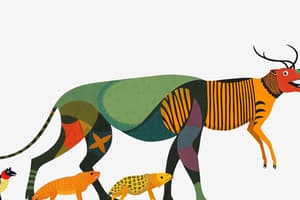Podcast
Questions and Answers
Los reptiles son animales de sangre fría que regulan su temperatura corporal a través de la absorción de calor del ambiente.
Los reptiles son animales de sangre fría que regulan su temperatura corporal a través de la absorción de calor del ambiente.
True (A)
Los mamíferos son organismos cubiertos de plumas que producen leche para alimentar a sus crías.
Los mamíferos son organismos cubiertos de plumas que producen leche para alimentar a sus crías.
False (B)
Las aves son animales vertebrados que ponen huevos con cáscara dura y tienen un sistema digestivo muy similar al de los reptiles.
Las aves son animales vertebrados que ponen huevos con cáscara dura y tienen un sistema digestivo muy similar al de los reptiles.
False (B)
Los equinodermos pertenecen al grupo de los invertebrados marinos y pueden incluir estrellas de mar y erizos de mar.
Los equinodermos pertenecen al grupo de los invertebrados marinos y pueden incluir estrellas de mar y erizos de mar.
Los platelmintos son un ejemplo de invertebrados marinos según la clasificación mencionada en el texto.
Los platelmintos son un ejemplo de invertebrados marinos según la clasificación mencionada en el texto.
¿Qué caracteriza a los anfibios en cuanto a su hábitat?
¿Qué caracteriza a los anfibios en cuanto a su hábitat?
¿Qué grupo de animales se caracteriza por la ausencia de órganos respiratorios dentro de sus órganos de movimiento?
¿Qué grupo de animales se caracteriza por la ausencia de órganos respiratorios dentro de sus órganos de movimiento?
¿A qué se refiere la clasificación de animales en vertebrados e invertebrados según el texto?
¿A qué se refiere la clasificación de animales en vertebrados e invertebrados según el texto?
¿Qué caracteriza a los animales protistas mencionados en el texto?
¿Qué caracteriza a los animales protistas mencionados en el texto?
¿Qué característica comparten los avoseros según el texto?
¿Qué característica comparten los avoseros según el texto?
Flashcards are hidden until you start studying
Study Notes
Classification of Animals
Classifying animals is crucial for understanding their evolutionary history, ecological roles, and relationships with other species. Several classification systems have been developed over time, including taxonomic hierarchies based on morphology, behavior, physiology, molecular biology, and ecology. This article focuses on two major classifications of animals: vertebrates and invertebrates.
Vertebrate Classification
Vertebrates are multicellular organisms that possess a backbone, also known as a spinal column, throughout their lives. They belong to the phylum Chordata, which includes three classes of aquatic larvae: Cephalochordata (tunicates), Pisces (fish), and Tetrapoda (amphibians, reptiles, birds, and mammals). Each class has specific characteristics that distinguish it from others within the group.
Fish (Pisces)
Fish are aquatic organisms characterized by gills that extract oxygen directly from water, fins for swimming, scales covering the skin, and lateral lines that detect pressure changes in the surrounding environment. There are over 38,000 known fish species, making them the largest class within the phylum Chordata.
Amphibians (Amphibia)
Amphibians are cold-blooded terrestrial or aquatic animals characterized by moist skin, lungs for respiration, and a specialized metamorphosis where they complete their life cycle in water before moving on land. Examples of amphibians include frogs, salamanders, and caecilians.
Reptiles (Reptilia)
Reptiles are ectothermic, scaled animals that absorb heat from their environment to regulate body temperature. They lay eggs on land and have dry skin with scales, claws, or both. This class includes snakes, lizards, crocodiles, and birds of prey like hawks and owls.
Birds (Aves)
Birds are warm-blooded, egg-laying vertebrates characterized by feathers, a beaked mouth without teeth, the laying of hard-shelled eggs, and a high metabolism. They possess light skeletons, powerful muscles, a four-chambered heart, and a strong yet flexible grip with their feet.
Mammals (Mamalia)
Mammals are warm-blooded, hair-covered organisms that produce milk to feed their young. They possess sweat glands, three middle ear bones, and mammary glands for lactation. Examples of mammals include humans, cats, dogs, whales, bats, and primates like monkeys, apes, and humans.
Invertebrate Classification
Invertebrates are multicellular organisms that lack a backbone throughout their lives. The phylum Echinodermata contains various classes of marine invertebrates such as sea stars, sea urchins, brittle stars, and sea cucumbers. Other major groups within the phylum Invertebrata include Porifera (sponges), Cnidaria (corals, jellyfish, sea anemones), Platyhelminthes (flatworms), Nematoda (roundworms), and Rotifera (wheel animals). Each group exhibits unique characteristics that differentiate them from other invertebrates in their assigned class.
Sponges (Porifera)
Sponges are simple aquatic creatures characterized by an opening called an ostium that serves both for entrance and exit of water. They feed by filtering small food particles from the water that flows through their body. Despite their simple structure, some sponge species exhibit complex behaviors such as coordinated feeding responses and cooperation between individuals during reproduction.
In conclusion, the classification of animals into vertebrates and invertebrates provides valuable insights into their evolutionary history, ecological roles, and relationships with other species. Understanding these classifications allows us to appreciate the diverse array of life forms that inhabit our planet Earth.
Studying That Suits You
Use AI to generate personalized quizzes and flashcards to suit your learning preferences.




